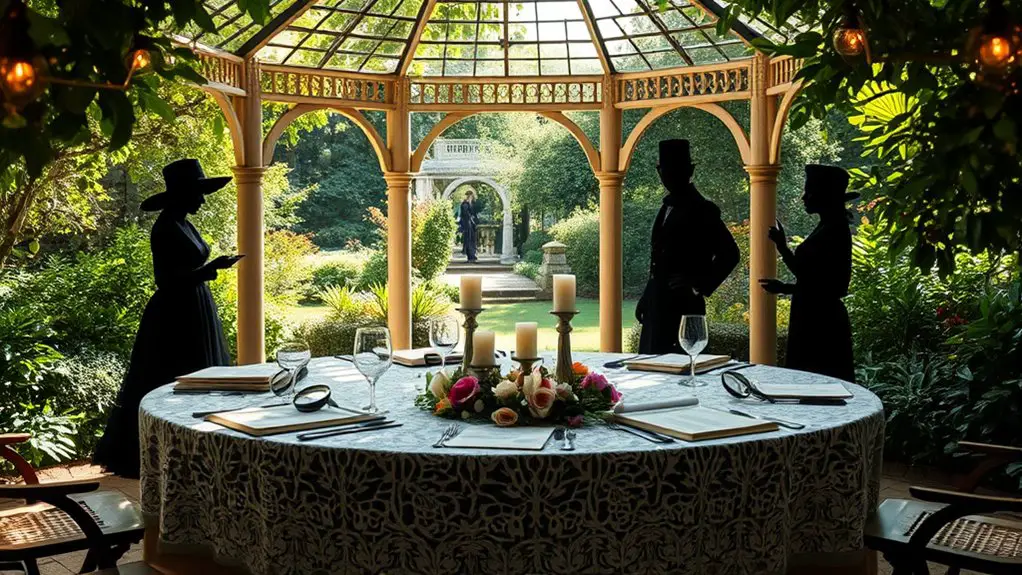To plan a murder mystery game in your gazebo, start by choosing an engaging theme that reflects your guests’ interests. Next, curate a guest list and assign roles that match their personalities. Set the scene with thematic decorations and props to enhance the atmosphere. Craft intriguing clues and puzzles that integrate with the storyline, and offer themed food and drinks for added immersion. Follow these tips for a smoothly run event, and you’ll discover even more exciting ideas.
Choosing the Right Theme for Your Murder Mystery
What kind of atmosphere do you want to create for your murder mystery game? Choosing the right theme is essential, as it sets the stage for thrilling character dynamics and engaging plots. Consider historical settings that transport players to different eras—like a roaring twenties speakeasy or a Victorian manor. These backdrops not only provide ambiance but also enrich character interactions, allowing guests to immerse themselves in their roles. The connections formed between characters can heighten suspense and intrigue, making the experience unforgettable. Tailor your theme to reflect your group’s interests, ensuring everyone feels invested. With the right theme, you’ll craft a murder mystery that invites creativity, fosters engagement, and keeps your guests on the edge of their seats.
Preparing the Guest List and Assigning Roles
As you commence on planning your murder mystery game, carefully preparing the guest list and assigning roles is essential for ensuring an engaging and immersive experience. Start by considering the guest dynamics—think about personalities, relationships, and how they’ll interact during the game. Aim for a mix of friends, acquaintances, and possibly a few newcomers to spice things up.
Next, focus on role distribution. Assign characters that match your guests’ interests and skills, ensuring everyone feels comfortable yet challenged. A detective might suit a naturally inquisitive friend, while a mysterious character could intrigue a more reserved guest. By thoughtfully curating your guest list and roles, you’ll set the stage for a memorable evening filled with intrigue and excitement.
Setting the Scene in Your Gazebo
To create an unforgettable atmosphere for your murder mystery game, you’ll want to choose decor that reflects the theme and era of your story. Think of incorporating vintage props, draped fabrics, and even some eerie elements to set the mood. Don’t forget about lighting—soft, dim lights or flickering candles can transform your gazebo into a suspenseful haven.
Choosing the Right Decor
While setting the scene in your gazebo for a murder mystery game, the right decor can transport your guests into a world of intrigue and suspense. Start with thematic centerpieces that capture the essence of your storyline—think vintage books, faux skulls, or mysterious artifacts. Enhance the atmosphere with interactive props that encourage participation and exploration. Below is a table to help you choose the perfect decor elements:
| Decor Type | Description | Example |
|---|---|---|
| Thematic Centerpieces | Create focal points that tell a story | Antique suitcase |
| Interactive Props | Engage guests in the mystery | Clue cards |
| Ambient Accents | Add depth and texture to the space | Candles and burlap |
Lighting for Atmosphere
Once you’ve set the scene with enchanting decor, the right lighting can elevate the atmosphere of your gazebo and draw guests deeper into the mystery. Consider using ambient lighting to create a warm, inviting glow. String lights draped across the beams or lanterns placed strategically on tables can enhance the mood and add a touch of elegance. Soft, colored light bulbs can also provide an intriguing effect, casting shadows that spark curiosity. For added drama, incorporate flickering candles or LED candles for a safe yet atmospheric choice. Remember, the goal is mood enhancement—so adjust the intensity to suit the unfolding narrative. With the perfect lighting, you’ll transform your gazebo into a mesmerizing space where every corner whispers a secret.
Crafting Engaging Clues and Puzzles
Crafting engaging clues and puzzles is essential for keeping your players intrigued and invested in the mystery. You’ll want to explore various types of clues that resonate with your storyline while considering puzzle difficulty levels to challenge participants without frustrating them. Integrating these elements seamlessly into your narrative will elevate the overall experience and encourage collaboration among players.
Types of Clues
When you design a murder mystery game, the types of clues you include can make or break the experience for your players. Consider using hidden messages that require deciphering. These can be in the form of coded notes or symbols cleverly integrated into the storyline. Physical clues, like a blood-stained handkerchief or a misplaced key, can also heighten the tension and intrigue. Think outside the box—perhaps a character’s diary contains crucial information or a family photo reveals unexpected connections. By combining hidden messages and physical clues, you’ll create a dynamic quest that encourages players to explore and interact. Remember, the thrill of discovery lies in the details, so make each clue count and keep the suspense alive!
Puzzle Difficulty Levels
How can you guarantee your puzzles strike the right balance between challenge and enjoyment? By understanding puzzle complexity levels, you can create an engaging experience. Consider the following table to help you adjust difficulty:
| Complexity Level | Player Experience |
|---|---|
| Easy | Quick wins to build confidence |
| Medium | Thought-provoking without frustration |
| Hard | For seasoned sleuths seeking a challenge |
Mix these levels throughout your game to maintain player experience balance. Easy puzzles can warm up participants, while harder ones can add a thrilling climax. Always gather feedback to refine your approach, ensuring everyone leaves with a sense of accomplishment, ready to tackle the next mystery in your gazebo!
Integration With Storyline
To guarantee your murder mystery game captivates players, integrating clues and puzzles seamlessly with the storyline is essential. Start by weaving character backstories into your clues; this not only personalizes the experience but also deepens engagement. For instance, a clue related to a character’s past can hint at their motives, making the mystery more compelling. Incorporate plot twists that challenge players’ assumptions—maybe a trusted character isn’t what they seem. This keeps everyone on their toes! Create puzzles that require players to piece together fragments of character histories or decode messages revealing hidden relationships. By linking clues to both the plot and character dynamics, you’ll craft an immersive experience where players feel free to explore, think critically, and enjoy the unfolding mystery.
Preparing Food and Drinks for the Event
While planning a murder mystery game, don’t overlook the importance of food and drinks, as they can enhance the atmosphere and keep your guests engaged. Here are some ideas to take into account:
Don’t forget food and drinks when planning a murder mystery game; they elevate the atmosphere and engage your guests.
- Themed Snacks: Serve bite-sized treats that reflect your game’s setting, like mini quiches for a Victorian theme or popcorn for a Hollywood mystery.
- Signature Cocktails: Craft a unique drink that ties into the plot, like “The Poisoned Martini” or “Murder on the Beach.”
- Mocktails: Remember to include non-alcoholic options to cater to all guests, ensuring everyone feels included.
- Dessert Table: Set up a sweet station with cupcakes or cookies decorated to match your theme, adding a fun touch to the event.
These elements will not only satisfy cravings but also immerse your guests in the experience!
Tips for Running the Game Smoothly
After setting the scene with delicious food and drinks, the next step is ensuring your murder mystery game runs without a hitch. Start by clearly explaining the rules and objectives to maintain game flow. Encourage players to immerse themselves in their roles; this boosts player engagement and keeps excitement high. Keep a watchful eye on the pacing—if things slow down, prompt discussions or introduce unexpected plot twists to reignite enthusiasm. Use a timer for each round, ensuring everyone has a chance to participate while preventing lulls. Finally, be ready to adapt; flexibility can turn potential hiccups into memorable moments. By fostering a lively environment, you’ll create an unforgettable experience for everyone involved!
Frequently Asked Questions
How Long Should the Murder Mystery Game Last?
When considering game duration, aim for 2-3 hours. This allows for engaging pacing strategies, ensuring players remain invested without feeling rushed. You’ll create an enjoyable atmosphere that encourages creativity and exploration throughout the experience.
Can I Host a Virtual Murder Mystery From My Gazebo?
Absolutely, you can host a virtual murder mystery from your gazebo! With a proper gazebo setup, you’ll create an inviting atmosphere, allowing everyone to engage in the fun while enjoying fresh air and a unique backdrop.
What Should I Do if a Guest Cannot Attend?
If a guest can’t attend, consider finding a substitute to take their place. Alternatively, you could reschedule the game to guarantee everyone can participate, keeping the fun and intrigue alive for all involved.
Can I Purchase Pre-Written Murder Mystery Kits?
Are you ready to unravel a mystery? Yes, you can purchase pre-written kits! Just keep budget considerations in mind; they vary widely. Choose one that fits your theme, and let the intrigue unfold beautifully.
How Do I Handle Disagreements Between Players During the Game?
When disagreements arise, encourage open player communication. Facilitate conflict resolution by allowing each side to express their views. Remind everyone that it’s all in good fun, fostering a collaborative atmosphere for an enjoyable experience.

